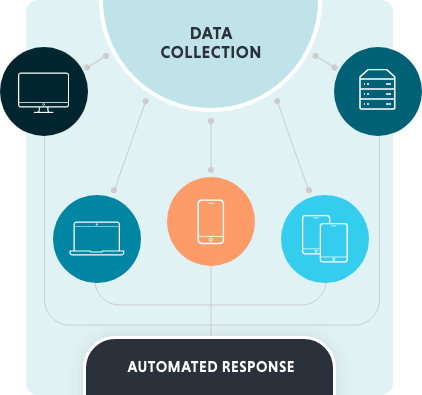
The cyber security landscape is constantly changing. Every step forward in technology creates new opportunities for bad actors to poke and prod and eventually crack even the latest security systems.
As attacks continue to grow in sophistication and frequency, one of the frontlines in the never-ending battle between criminals and IT is the endpoint — the devices and computing resources that are connected to a network.
These can be anything from laptops and smartphones, to webcams, tablets, and servers. And without the right security measures in place, each can be used as the entryway for an attack.
Because of this, endpoint detection and response (EDR) is now a critical focus for organizations.
What is EDR?
In a nutshell, it’s a comprehensive approach for monitoring and protecting endpoints. There are two components to it: Endpoint Protection (EP) and Endpoint Detection (ED). Think of these components this way:
EP is the reactive component of EPR and is focused on real-time monitoring and rapid response to security incidents.
ED is the proactive aspect of EPR that aims to prevent security breaches and attacks. It encompasses a wide range of technologies and strategies to secure devices, networks, and data.
How does EDR work?
EDR is not a one-shot measure, but rather, a continuous cycle that combines prevention, detection, analysis, and response to protect your organization’s digital assets.
Prevention: Antivirus and anti-malware software scans and removes known threats from endpoints. Firewalls block unauthorized network traffic. Security policies restrict access to sensitive data and resources.
Detection: EDR tools constantly monitor endpoint activities to collect data on file changes, network connections, and user behavior. Advanced analytics and machine learning algorithms identify unusual or suspicious activities that may indicate a security breach. Threat intelligence feeds provide up-to-date information on the latest known threats and attack patterns.
Analysis: Incident investigation tools provide IT and security teams with detailed data on an incident so they can investigate and assess its impact. Correlation of data from multiple endpoints and network sources then determines the scope of the incident and any lateral movement within a network.
Response: Once an incident is confirmed, EDR tools can isolate the affected endpoints or networks to prevent the spread of the threat. IT teams can then take necessary actions to remove malware, patch vulnerabilities, and mitigate the damage. Comprehensive reports are generated to help IT understand what happened and how to prevent similar attacks in the future.
IT at the center
Post-pandemic, most businesses now have many more devices to keep track of. Laptops, smartphones, tablets — each is an endpoint out in the wild.
Monitoring and protecting these endpoints is the role of IT. Their responsibilities include:
Choosing the right tools in alignment with an organization’s specific needs and risk profile
Properly configuring and fine-tuning tools to ensure they provide optimal protection without causing disruptions to daily operations
Keeping an updated inventory of all company endpoints and tracking hardware and software changes
Regularly deploying the latest security patches to mitigate vulnerabilities as soon as they’re discovered
Enforcing device control policies to prevent unauthorized or unsecured devices from accessing the network
Additionally, IT departments need to have predefined incident response plans in place to act quickly when a security incident occurs. These plans must include ways to isolate compromised endpoints, how to deal with the issue, and ways to document the incident for analysis.
EDR tools
As the need for EDR has increased, the tools available have become much more robust.
Two of the tools we often recommend to companies are Microsoft Defender for Endpoint and Microsoft Defender Vulnerability Management, but there are scores of others available.
Like any software, choosing the right solution for your business will often come down to your choice of operating system and hardware. But at bare minimum, whichever tool you go with should provide you with:
The ability to consistently monitor usage of your network and all of your devices
Real-time reporting and alerts
Automatic investigation and remediation capabilities
Baseline assessments to identify security changes in real-time
A dashboard providing a high-level view of your exposure score, threat awareness, expiring certificates, device exposure, and more
Safety first
As the number of connected devices continues to grow, it’s critical for organizations to ensure the tools their employees use are secure.
EDR is an essential strategy for doing just that, combining proactive protection with real-time monitoring and rapid response.
It’s not just a suite of tools, it’s an entire security philosophy that makes it possible for companies to adopt new technologies without inviting bad actors to have access to sensitive information.
No security system is foolproof. But when implemented following best practices, EDR is close to complete protection. That makes it an essential strategy in today’s business.


